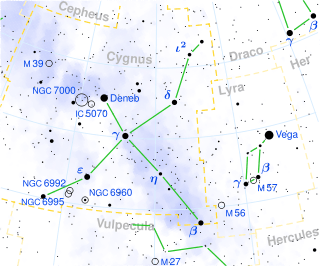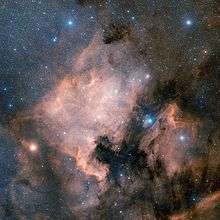Xi Cygni

| |
| Observation data Epoch J2000 Equinox J2000 | |
|---|---|
| Constellation | Cygnus |
| Right ascension | 21h 04m 55.86s[1] |
| Declination | +43° 55′ 40.3″[1] |
| Apparent magnitude (V) | 3.73[2] |
| Characteristics | |
| Spectral type | K4:Ib- + A1.5V[3] |
| U−B color index | +1.78[2] |
| B−V color index | +1.66[2] |
| Astrometry | |
| Radial velocity (Rv) | -19.10[4] km/s |
| Proper motion (μ) | RA: +7.97[1] mas/yr Dec.: +0.06[1] mas/yr |
| Parallax (π) | 3.87 ± 0.16[1] mas |
| Distance | 361[3] pc |
| Absolute magnitude (MV) | −4.3/+1.3[3] |
| Orbit[5] | |
| Period (P) | 6,750 ± 200 days |
| Semi-major axis (a) | ~766 R☉ |
| Eccentricity (e) | 0.25 ± 0.07 |
| Inclination (i) | ~50° |
| Details | |
| Primary | |
| Mass | ~8[5] M☉ |
| Radius | 200[5] R☉ |
| Luminosity | 5,303[6] L☉ |
| Surface gravity (log g) | 1.00[7] cgs |
| Temperature | 3,920[7] K |
| Metallicity [Fe/H] | −0.41[7] dex |
| Secondary | |
| Mass | ~2.5[5] M☉ |
| Other designations | |
| Database references | |
| SIMBAD | data |
Xi Cygni is a spectroscopic binary star in the constellation Cygnus. Its apparent magnitude is 3.73 and it is located around 360 parsecs (1,200 ly) away.
The system contains two stars which orbit every 18 years in a mildly eccentric orbit. The primary star is a supergiant of spectral type around K4, while the secondary is a A-type main-sequence star of spectral type A1.5. Stellar winds from the supergiant have been measured at around 50 km/s, but with variations in speed and individual line strengths.[5]
ξ Cygni is in the Kepler field of view but no planets have been detected.[8]

NGC 7000 (North America Nebula). ξ Cygni is the bright star on the left.

H-alpha view of the nebulosity near ξ Cygni
References
- 1 2 3 4 5 van Leeuwen, F. (November 2007). "Validation of the new Hipparcos reduction". Astronomy and Astrophysics. 474 (2): 653–664. arXiv:0708.1752
 . Bibcode:2007A&A...474..653V. doi:10.1051/0004-6361:20078357.
. Bibcode:2007A&A...474..653V. doi:10.1051/0004-6361:20078357. - 1 2 3 Ducati, J. R. (2002). "VizieR Online Data Catalog: Catalogue of Stellar Photometry in Johnson's 11-color system". CDS/ADC Collection of Electronic Catalogues. 2237: 0. Bibcode:2002yCat.2237....0D.
- 1 2 3 Ginestet, N.; Carquillat, J. M. (2002). "Spectral Classification of the Hot Components of a Large Sample of Stars with Composite Spectra, and Implication for the Absolute Magnitudes of the Cool Supergiant Components". The Astrophysical Journal Supplement Series. 143 (2): 513. Bibcode:2002ApJS..143..513G. doi:10.1086/342942.
- ↑ Famaey, B.; et al. (January 2005), "Local kinematics of K and M giants from CORAVEL/Hipparcos/Tycho-2 data. Revisiting the concept of superclusters", Astronomy and Astrophysics, 430 (1): 165–186, arXiv:astro-ph/0409579
 , Bibcode:2005A&A...430..165F, doi:10.1051/0004-6361:20041272
, Bibcode:2005A&A...430..165F, doi:10.1051/0004-6361:20041272 - 1 2 3 4 5 Reimers, D.; Schroeder, K.-P. (1989). "Observations of modulation and phase displacement of the stellar wind in six red giant spectroscopic binaries". Astronomy and Astrophysics. 214: 261. Bibcode:1989A&A...214..261R.
- ↑ McDonald, I.; Zijlstra, A. A.; Boyer, M. L. (2012). "Fundamental parameters and infrared excesses of Hipparcos stars". Monthly Notices of the Royal Astronomical Society. 427: 343. arXiv:1208.2037
 . Bibcode:2012MNRAS.427..343M. doi:10.1111/j.1365-2966.2012.21873.x.
. Bibcode:2012MNRAS.427..343M. doi:10.1111/j.1365-2966.2012.21873.x. - 1 2 3 Hekker, S.; Meléndez, J. (2007). "Precise radial velocities of giant stars. III. Spectroscopic stellar parameters". Astronomy and Astrophysics. 475 (3): 1003. arXiv:0709.1145
 . Bibcode:2007A&A...475.1003H. doi:10.1051/0004-6361:20078233.
. Bibcode:2007A&A...475.1003H. doi:10.1051/0004-6361:20078233. - ↑ Molenda-Żakowicz, J.; Sousa, S. G.; Frasca, A.; Uytterhoeven, K.; Briquet, M.; Van Winckel, H.; Drobek, D.; Niemczura, E.; Lampens, P.; Lykke, J.; Bloemen, S.; Gameiro, J. F.; Jean, C.; Volpi, D.; Gorlova, N.; Mortier, A.; Tsantaki, M.; Raskin, G. (2013). "Atmospheric parameters of 169 F-, G-, K- and M-type stars in the Kepler field". Monthly Notices of the Royal Astronomical Society. 434 (2): 1422. Bibcode:2013MNRAS.434.1422M. doi:10.1093/mnras/stt1095.
This article is issued from Wikipedia - version of the 8/18/2016. The text is available under the Creative Commons Attribution/Share Alike but additional terms may apply for the media files.